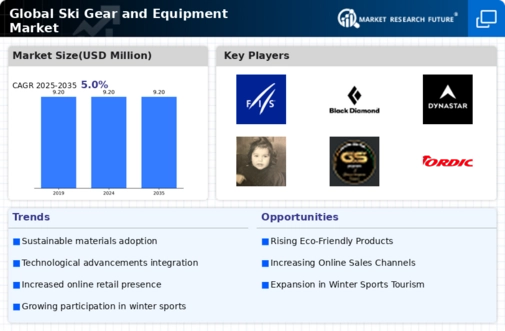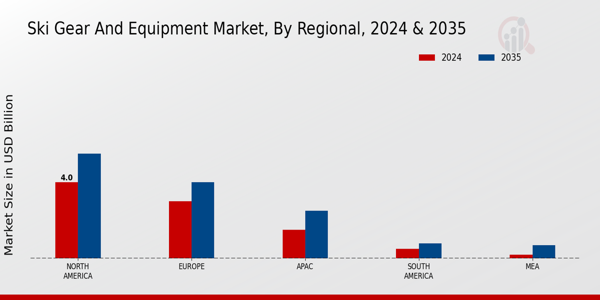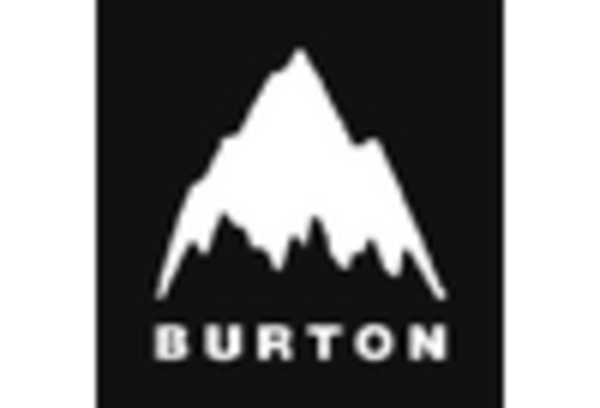Rise of Eco-Friendly Products
The growing emphasis on sustainability is influencing consumer preferences in The Global Ski Gear and Equipment Industry. As environmental concerns become more pronounced, consumers are increasingly seeking eco-friendly products made from sustainable materials. This shift is prompting manufacturers to adopt greener practices in their production processes, leading to the development of biodegradable and recyclable ski gear. Market analysis indicates that the segment of eco-friendly ski equipment is expected to grow by 15% annually, reflecting the rising demand for sustainable options. This trend not only aligns with consumer values but also positions brands favorably in a competitive market. As awareness of environmental issues continues to rise, the demand for sustainable ski gear is likely to become a defining characteristic of the industry.
Growing Awareness of Safety Standards
Safety considerations are becoming increasingly paramount in The Global Ski Gear and Equipment Industry. As skiing and snowboarding can pose risks, consumers are more inclined to invest in gear that meets stringent safety standards. This heightened awareness has led to a surge in demand for helmets, protective gear, and safety-enhanced equipment. Recent surveys indicate that over 70% of skiers prioritize safety features when purchasing gear, which has prompted manufacturers to focus on compliance with international safety regulations. The market for safety-oriented ski gear is expected to expand significantly, with projections indicating a growth rate of 8% over the next five years. This trend underscores the importance of safety in driving consumer purchasing decisions and shaping product development.
Technological Advancements in Equipment
Technological innovation plays a crucial role in shaping The Global Ski Gear and Equipment Industry. The introduction of advanced materials and smart technologies has revolutionized the design and functionality of ski gear. For instance, the integration of lightweight materials enhances performance while ensuring durability. Additionally, smart technology, such as GPS tracking and performance monitoring, is becoming increasingly prevalent in ski equipment. This trend not only appeals to tech-savvy consumers but also enhances safety and performance on the slopes. Market data suggests that the segment of high-tech ski gear is projected to grow at a rate of 10% annually, reflecting the increasing consumer preference for innovative products. As manufacturers continue to invest in research and development, the market is likely to witness a continuous influx of cutting-edge equipment.
Increased Participation in Winter Sports
The rising interest in winter sports has been a pivotal driver for The Global Ski Gear and Equipment Industry. As more individuals engage in skiing and snowboarding, the demand for high-quality gear and equipment has surged. Recent statistics indicate that participation in winter sports has increased by approximately 15% over the past five years, leading to a corresponding rise in sales of ski gear. This trend is particularly evident among younger demographics, who are increasingly drawn to outdoor activities. The growing popularity of ski resorts and winter sports events further fuels this demand, as enthusiasts seek to enhance their experience with advanced equipment. Consequently, manufacturers are compelled to innovate and expand their product lines to cater to this expanding consumer base.
Expansion of Ski Resorts and Infrastructure
The expansion of ski resorts and related infrastructure is a significant driver of The Global Ski Gear and Equipment Industry. As new ski resorts emerge and existing ones enhance their facilities, the accessibility and appeal of winter sports increase. This expansion not only attracts more tourists but also encourages local participation in skiing and snowboarding. Recent reports indicate that the number of ski resorts has grown by approximately 12% in the last decade, contributing to a larger consumer base for ski gear. Furthermore, improved transportation and accommodation options enhance the overall experience for visitors, leading to increased spending on equipment. As the infrastructure continues to develop, the market is likely to benefit from a sustained influx of new participants and enthusiasts.


















Leave a Comment